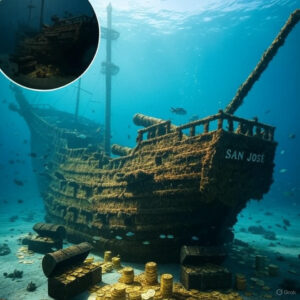After more than three centuries beneath the Caribbean Sea, the legendary Spanish galleon San José has finally been discovered off the coast of Cartagena, Colombia. Often called “the Holy Grail of Shipwrecks,” the vessel lay hidden since 1708, when it was sunk during a fierce naval battle with the British. Now, explorers describe an almost surreal underwater world — beams of sunlight piercing turquoise waters to reveal mountains of gold coins, silver bars, and emeralds glittering amid coral-covered cannons and fragments of shattered porcelain.

The treasure aboard the San José is estimated to be worth more than $20 billion, but its true value lies far beyond wealth. Each artifact tells a story of empire, ambition, and tragedy — a time when Spain’s colonial power depended on ships like this one to ferry riches from the Americas to Europe. The wreck also revives centuries-old disputes: Who owns the treasure? Spain, Colombia, or the descendants of the ship’s original crew?
As modern technology prepares to raise the ship from its watery tomb, historians and governments alike face a profound challenge — to balance cultural heritage with national interest, to preserve history without exploiting it. The San José is not merely a sunken fortune; it is a ghost from the past, a silent witness to the tides of conquest and loss. After three hundred years, the galleon’s return to the surface invites the world to rediscover not only its gold, but the human stories buried with it.
Leave a Reply